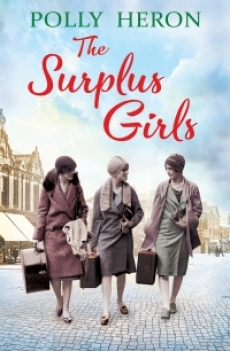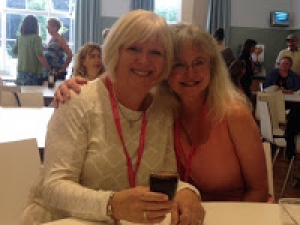In case you missed it on Jan Baynham's blog, here is she interview she conducted with me in my Polly Heron guise. I love the question about book groups - I've never been asked that one before.
Here am I with Jan at an RNA Conference:
* * * *
Introducing Polly Heron I’m delighted to welcome author Polly Heron to the blog for the first time. Polly lives on the beautiful North Wales coast but originally hails from Manchester, which provides the setting and inspiration for her family sagas. Her new book The Surplus Girls will be published by Corvus on January 2nd 2020. Polly also writes as Susanna Bavin.
Polly, welcome. Please tell us about your writing. What is the appeal of family sagas to you? It’s lovely to be here, Jan. Thank you for inviting me. I suppose that, like many writers, I write what I want to read. I love strong, dramatic story-lines peopled by well-rounded, credible characters who develop and are changed by their experiences. For me, the cherry on the cake is the historical setting. I am fascinated by social history. I love to see characters, especially women, having to cope with challenges within the social and legal context of the time. I also enjoy the domestic history – the clothes, food, furniture and so on.
|
The Surplus Girls is your first book writing as Polly Heron. What is the novel about and what was its inspiration?
The real surplus girls were that generation of young women whose possible husband perished on the battlefields in the Great War. These were girls who had grown up expecting to get married, but now they faced a lifetime of fending for themselves. I have always been interested in the problems women faced in the past and this one appealed to me, partly because it is in living memory. When my mother was at grammar school, her teachers had been surplus girls. |  |
How will the novel fit in with your other books, written as Susanna Bavin? For example, the themes, location and historical period? Certain themes will be familiar to readers of my Susanna Bavin books – the social and financial position of women in the past. There is a will that causes complications. I once heard a radio programme about wills and a solicitor said, ‘Where there’s a will, there’s a war.’ I love that! A will featured in The Poor Relation and there’s another in The Surplus Girls. And I also explore the themes of loss and loyalty, both of which are deeply important to Belinda, the heroine.
As for the period, the book is set in 1922, so around the same time as The Deserter’s Daughter and A Respectable Woman. And I explore familiar territory, as much of the story is set in Chorlton, though Belinda’s family lives up the road in Stretford. My dad was a talented artist and he drew some highly detailed maps of Chorlton as it was when he was growing up in the 20s and 30s, so I know the exact location of various shops etc.
Having been impressed that you’ve previously written detailed synopses of your novels before writing them, I now try to do that myself as part of planning a new story. Did you do that for The Surplus Girls? Very much so! When you’re writing a series, you can’t afford to take chances. Whatever gets published in book 1, you’re stuck with, even if it turns out to be unhelpful to what happens in book 2 or 3, so it seems to me that planning in advance is essential. I have a mammoth 20-something page synopsis. Planning in detail was a big help in creating the links between the stories. For example, there is a small plot-point in book 1 that turns into a major plot-point in book 3.
Which came first, the characters or the plot? The characters, definitely. The heroine is Belinda, who got engaged to Ben when she was just 15 and went to live with his mother and grandmother. She was more than happy to do so, not just to be part of Ben’s family, but also to escape from a pretty awful home life with her money-grabbing, ne’er-do-well father and downtrodden, self-pitying mother, not to mention younger brothers running wild. But Ben is killed in action in the final year of the Great War, leaving Belinda in the odd position of being almost-but-not-quite a widow. Four years later, when the story starts, Belinda has laid Ben’s memory to rest, but his mother and grandmother very definitely haven’t. How can Belinda start to make something of her life when the two women to whom she owes so much are determined to keep her swathed in black for ever?
With Belinda and her situation so firmly established in my mind, it was easy to see how her plot would develop. The same is true of Gabriel, the hero.
What are the plans for subsequent books? The heroine of the second book is Molly. She is very different to Belinda – older, more experienced. If the themes of Belinda’s story are loss and loyalty, then Molly’s are independence and what we would call sexism. Although each book is part of the series, each one will also be a stand-alone novel.
If the book is chosen by a book group, what do you think would make a good discussion question? What a brilliant question. It so happens that on my Susanna Bavin website, I have a page of book group questions for each of my novels and I am in the process of building a bank of questions for The Surplus Girls.
A general question about the book as a whole would be: In the book, is it preferable to be a wife, a widow or a spinster?
A question specific to Belinda would be: Does Belinda spend too much time trying to please other people?
Thank you, Polly. I can’t wait to read your new book and be introduced to Belinda and the other characters in The Surplus Girls.
* * * *
Polly's website: pollyheron.co.uk
Polly's author page on Amazon
On Twitter: @SusannaBavin
|



Make A Comment
Comments (0)